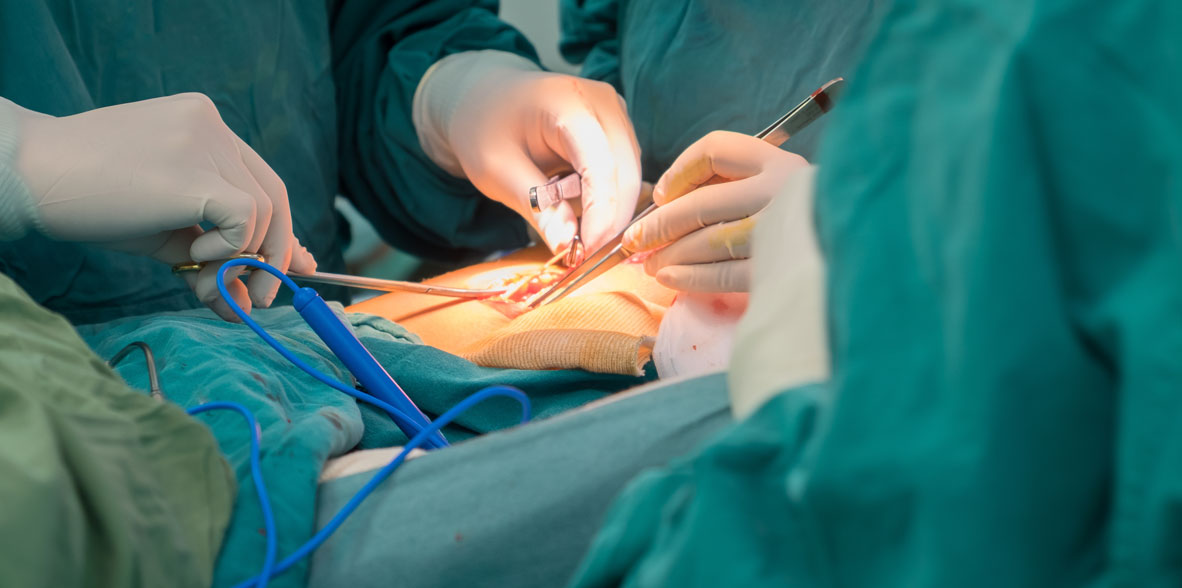

 Centro Médico Teknonen/health-centers/centro-medico-teknon
Centro Médico Teknonen/health-centers/centro-medico-teknon
Gallbladder lithiasis is one of the main pathologies in national health resulting in more than 500000,40 cholecystectomies per year. Most surgeries are for symptomatic vesicular lithiasis and more than 90% of cholecystectomies are performed laparoscopically. Other forms of treatment are palliative and non-curative.
Symptoms and diagnosis
What is biliary or vesicular colic?
Patients with gallbladder lithiasis report suffering from transient or constant pain after eating (especially foods rich in fat) located on the right and upper abdomen (right hypochondrium) or in the center of it (epigastrium), accompanied by nausea and sometimes vomiting of food or yellow content (biliary), for a period between 1 and 24 hrs. This is considered as a typical biliary colic produced by vesicular lithiasis. Removal of the gallbladder and stones (cholecystectomy) is the best treatment for these patients. Sometimes the pain radiates to the back (interscapular space in the dorsal region). In some patients the symptoms are less intense and consist only of vague abdominal discomfort (in the "mouth of the stomach") or dyspepsia.
The diagnosis of gallbladder lithiasis is usually made by ultrasound or abdominal ultrasound. The ultrasonographic finding, thickening of the vesicular wall or perivesicular fluid suggest the presence of acute cholecystitis.
Treatment
Asymptomatic vesicular lithiasis is not an indication for cholecystectomy unless the vesicular wall is thickened (4 mm or more) or calcified or the stones are larger than 3 cm in diameter. When the patient with vesicular lithiasis begins with pain in the upper abdomen that has no other origin, elective cholecystectomy is indicated. There are urgent indications of cholecystectomy such as: acute cholecystitis, severe biliary pancreatitis and cholangitis.
The patient should consult with a surgeon if the acute episode was resolved or if the symptoms decreased. Patients who present with significant pain and defense in the right hypochondrium, fever and leukocytosis should be seen immediately by a surgeon. Alternative treatments such as dissolution of stones with oral agents, extracorporeal shock waves with lithotrípsia and direct dissolution of stones with injection of solvents directly into the gallbladder are not standard forms of treatment and are reserved for special situations. Cholecystectomy may occasionally be indicated in patients with gallbladder pain without lithiasis (alithiasic cholecystitis).
Cholecystectomy can be performed laparoscopically or conventionally (open). The advantages of laparoscopic cholecystectomy are: a short hospital stay, quick return to work and minimal scarring. The disadvantages are limited vision of the abdominal contents and the inability to palpate the bile duct and other abdominal organs.
Complications
In patients undergoing elective cholecystectomy, complications referred specifically to cholecystectomy include: bile duct injury, residual lithiasis (leaving stones in the main bile duct (common bile duct) and injury to neighboring organs.
Conversion from laparoscopic to conventional open cholecystectomy
Although laparoscopic cholecystectomy is feasible in most patients, conversion to an open procedure is usually necessary in some patients. The conversion should not be considered as a complication in itself, but as an appropriate decision, when there is the presence of adhesions, difficulties in delimiting the anatomy or when there is suspicion of injuries. Then conversion to an open procedure can avoid complications.
The conversion is more frequent in surgeries of elderly patients, in those who present: previous surgeries in the upper abdomen, thin vesicular wall or acute cholecystitis. The incidence of conversion to an open procedure is 5 to 10%.
Prognosis
In most patients with ASA I and II surgical risk, elective laparoscopic cholecystectomy does not require more than 24-28 hrs. admission to the clinic. ASA III and IV emergency operations require a longer postoperative period. In open cholecystectomy, patients are discharged approximately 4-7 days after surgery. Hospital admission may be prolonged in patients in whom abdominal drainage, bile duct exploration or in those who have a bile duct complication are necessary. Cholecystectomy patients have pain remission in 95% of cases. The 5% that continues with pain is due to the fact that the origin of the pain is from another cause other than vesicular lithiasis. Some patients develop cramps, bloating, bloating, diarrhea, or heartburn before surgery. These symptoms are not related to vesicular pathology and do not diminish after cholecystectomy. They can be controlled by diet, or by treating if there is a cause that causes it such as in patients with heartburn who require reflux treatment.
Treatment of main bile duct lithiasis (Common bile duct)
Options for treating bile duct stones can be surgical or endoscopic. Endoscopic treatment is indicated in patients with cholangitis, severe pancreatitis or obstructive jaundice. Endoscopic treatment of bile duct lithiasis is effective but is associated with a low risk of pancreatitis, bleeding, or perforation. Surgical treatment of bile duct lithiasis can be performed laparoscopically if the appropriate instruments are available and if the surgical team is experienced. Open cholecystectomy with bile duct exploration is a safe and effective treatment especially in patients with an acute condition. Non-surgical treatment of bile duct lithiasis in patients who still have a gallbladder should be performed after consultation with a surgeon. As most bile duct stones come from the gallbladder, cholecystectomy is indicated unless the patient has an elevated surgical risk.



































